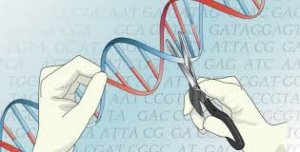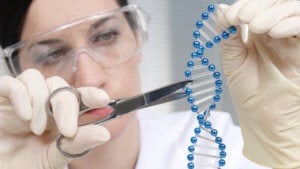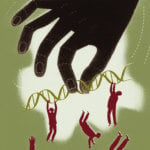Initial public outcry over a novel medical technology isn’t anything new: vaccines, transfusions, transplants, recombinant DNA, in vitro fertilization, preimplantation genetic diagnosis, GMOs, gene therapy – the list is long. But genome editing, using tools such as CRISPR, seems to have struck a public nerve in a more profound way, largely because of the reported rush to tinkering with human fertilized ova, an intervention that would alter the genomes of future generations.
But what does the public really understand about “clustered regularly interspaced short palindromic repeats,” aka CRISPR? It’s fairly complicated to follow the details – the choreography of DNA, RNA and proteins; nuances of repeated and unique DNA sequences; details of recombination and DNA repair. But a PhD certainly isn’t necessary to ponder the consequences of the ability to modify the human germline – the DNA that’s passed on to future generations.
 A carefully designed and tested questionnaire
A carefully designed and tested questionnaire
In a paper in the January 2019 issue of Human Gene Therapy, Alex Hewitt, of the Menzies Institute for Medical Research at the University of Tasmania, a professor of ophthalmology who also has a PhD, and colleagues probed the reasons behind public perception of human gene editing. The study actually began with a 17-item questionnaire launched in 11 languages in June 2015 with ads on Facebook, Twitter, Google and WeChat. It attracted responses from 185 countries from 12,562 people, who ranged in age from 11 to 90 (average 32), and were 37 percent female. Initial analysis led to a 2016 study, A Global Social Media Survey of Attitudes to Human Genome Editing, published in Cell Stem Cell.
The survey was carefully worded to avoid possibly emotional terms, such as “enhancement,” “augmentation,” and even “CRISPR,” using “genetic engineering,” “gene editing,” “genetic editing” and “genome editing” synonymously.
The basis of the new analysis is 3,988 “textual responses,” in which people answered the open-ended query in item 17: “Please describe the factors that have influenced your response or attitude toward human gene engineering.” The researchers drew intriguing inferences from respondents’ word choices.

Iterations of the survey asked people what they thought each question meant, allowing the researchers to refine and improve clarity. For example, in “’thinking-aloud cognitive phase testing,’ “we found that the message of the question was aided by the inclusion of the phrase: ‘This means that all future generations would not have the disease.’ So we hoped that this statement would convey the fact that genetic editing of an embryo would affect subsequent generations, as opposed to somatic editing, which clearly would not,” Dr. Hewitt told Genetic Literacy Project, referring to modifying cells from children or adults.
The questions
The first seven questions collected demographic info. Then a few questions probed family history of genetic disease, and then the all-important distinguishing embryos from children or adults.
The next five questions asked how much the person agrees with the use of gene editing of cells in children or adults to “cure” a life-threatening disease or a debilitating disease, then editing embryos to “prevent” a life-threatening disease or a debilitating disease, with the fifth question concerning using the technology on embryos for a “nondisease characteristic” such as eye color, height or memory.
The design of the questions distinguishes effects before and after birth and each has a qualifier: “This means that the disease could still be passed on to their children” following the intervention in children or adults,” for example. It uses plain language to distinguish somatic from germline intervention, assuming that by “embryo” the researchers mean “fertilized ovum” so that all cells are affected.
The qualifier after the embryo questions is the aforementioned “This means that all future generations would not have the disease.” It’s a bit of an oversimplification, because it takes two to do a genetic tango, Mendel’s first law. Partners can bring in mutations, so a disease isn’t guaranteed to vanish instantly and forever by tinkering with one genome. All of our cells except eggs and sperm have two.
 The next four questions address non-health-related traits: appearance, intelligence, strength or sporting ability, and a request for the respondents’ opinion of other traits. Question 16 asks about agreeing with the use of genetically-modified foods, and number 17 is the all-important write-in of reasons.
The next four questions address non-health-related traits: appearance, intelligence, strength or sporting ability, and a request for the respondents’ opinion of other traits. Question 16 asks about agreeing with the use of genetically-modified foods, and number 17 is the all-important write-in of reasons.
The first analysis in 2016 revealed that respondents generally supported gene editing in embryos as well as kids and adults for health-related purposes, but not for enhancement and eugenic aims. A further analysis of key words and “curation of nonsensical answers” of the open-ended question, using a technique called “topic modeling,” revealed, to an extent, the reasoning behind the thumbs-up or thumbs-down of gene editing.
Findings reveal thirst for knowledge
Of the respondents, 45 percent went to college, 45 percent had a religious affiliation, and 23 percent worked in health care. A third had “significant prior knowledge” of gene editing while 12 percent hadn’t heard of it, which raises the question of why they offered opinions in the survey.
Perhaps not surprisingly, people were more likely to object to editing the genes of embryos than of children or adults. Respondents who were against gene editing to help a child or adult with a health condition were more likely to use words indicating “Better Understanding” than folks who agreed to gene editing for this purpose. The researchers interpreted this observation to mean that people against the technology just want to learn more about it.

Some of the demographic questions and interpretation of answers leaned towards stereotyping. For example, people from the UK or Australia more often wrote “Future Generations” than people from Japan, China or France. Chinese respondents indicated “Better Understanding,” and perhaps that’s not surprising given the outcry at the November 25 announcement that defrocked researcher He Jiankui, of Southern University of Science and Technology in Shenzhen. He revealed that he had gene-edited two babies at the instant that sperm met eggs to engineer resistance to HIV infection, announced via YouTube on November 25, 2017. It was a proof-of-principle stunt widely misinterpreted to be an attempt to prevent AIDS.
The researchers interpreted these findings to mean that “it appears that the opinions of respondents from Western countries are shaped by the impact of embryonic gene editing on future generations, whereas in general, Eastern respondents were more greatly influenced by the progress of research and ensuring technical proficiency.”
The paper also states that Christians are more interested in “Future Generations” and Muslims more interested in “Research,” leading me to wonder about people of other religions or atheists. The investigators attribute Christian resistance to gene editing to “values arising from living in a Christian environment, which culturally places special emphasis on embryos and other body parts.” I find that nearly as offensive as the claim that “family values” are uniquely Christian. Maybe I’m reading too much into it.

But the major conclusion, that people currently against the use of gene editing in kids and adults seek “better understanding,” is great news. Probing public acceptance or rejection of human gene editing is in its infancy, and the data that these researchers have collected will continue to yield important insights.
“It would be neat to set something up similar to the moral machine experiment to take the pulse of the community,” said Dr. Hewitt. A moral machine is “a platform for gathering a human perspective on moral decisions made by machine intelligence,” described in a recent article in Nature.
It will certainly be intriguing to track the changes in public perception as CRISPR and related gene editing technologies graduate from preclinical and early phase clinical trials and head towards FDA approval.
Ricki Lewis is the GLP’s senior contributing writer focusing on gene therapy and gene editing. She has a PhD in genetics and is a genetic counselor, science writer and author of The Forever Fix: Gene Therapy and the Boy Who Saved It, the only popular book about gene therapy. BIO. Follow her at her website or Twitter @rickilewis































